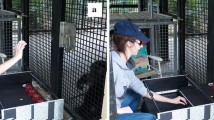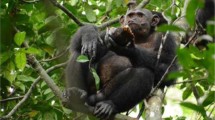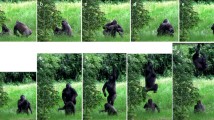Abstract
Five dyads of chimpanzees were tested in a competitive situation, as a pilot study to examine chimpanzees’ understanding of conspecifics’ knowledge. A human experimenter baited one of five containers in an outdoor enclosure. Chimpanzee A (witness) could see where the food was hidden, while chimpanzee B (witness-of-witness) could not see the baited place but could observe the chimpanzee A watching the food being hidden. Then the two were released into the enclosure. This procedure was repeated for a certain number of days along with a control condition in which neither could see the baited location. The witness-of-witness developed tactics to forestall the witness in two pairs. The witness misled the witness-of-witness by taking a route to an empty container in several cases. These episodes might represent examples of deception. Tactics and counter-tactics thus developed through the interaction between the witness and the witness-of-witness, illustrating the high social intelligence of chimpanzees. An examination of the changes in tactics suggests a possibility that the witness-of-witness understands the witness’s knowledge of the location of hidden food.
Similar content being viewed by others
Author information
Authors and Affiliations
Additional information
Accepted after revision: 22 May 2001
Electronic Publication
Rights and permissions
About this article
Cite this article
Hirata, S., Matsuzawa, T. Tactics to obtain a hidden food item in chimpanzee pairs (Pan troglodytes). Anim.Cogn. 4, 285–295 (2001). https://doi.org/10.1007/s100710100096
Received:
Published:
Issue Date:
DOI: https://doi.org/10.1007/s100710100096




